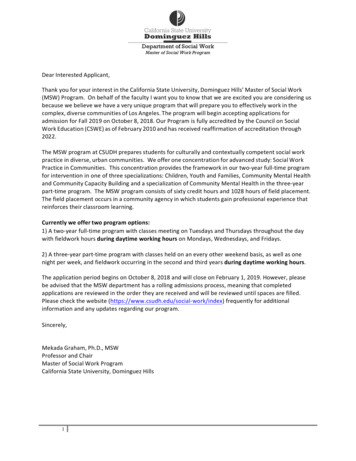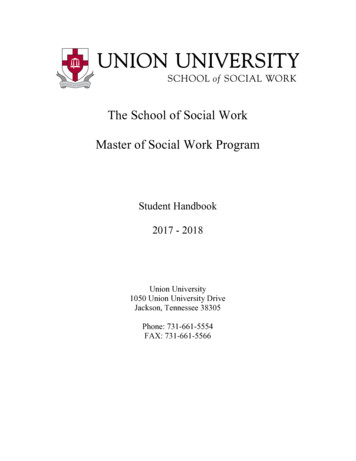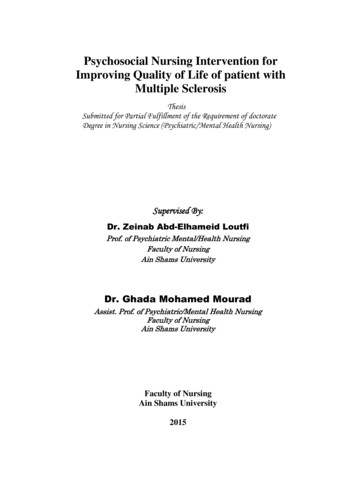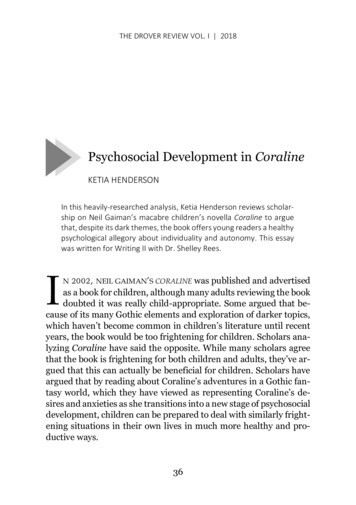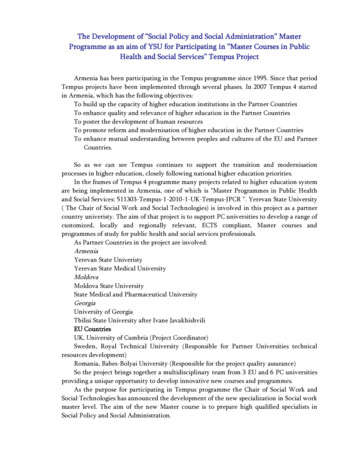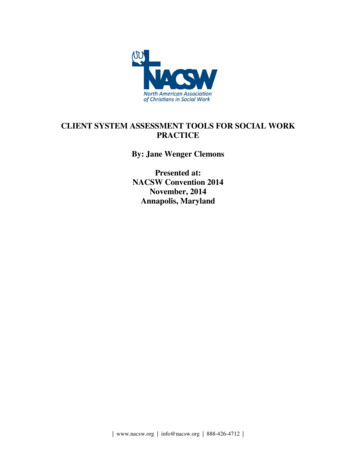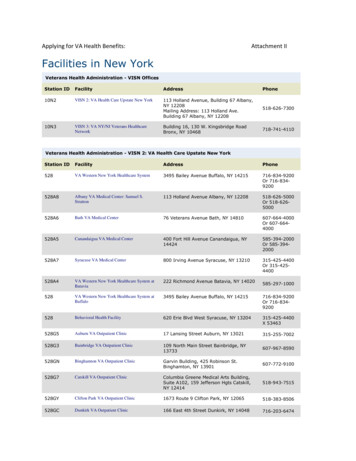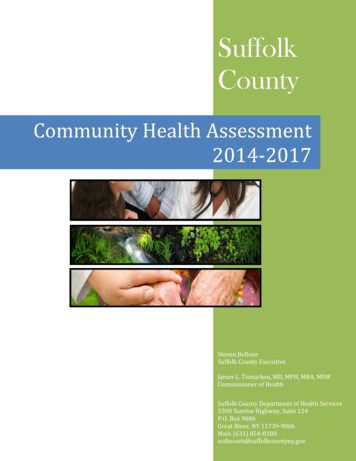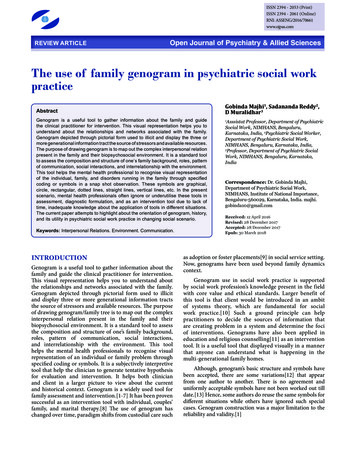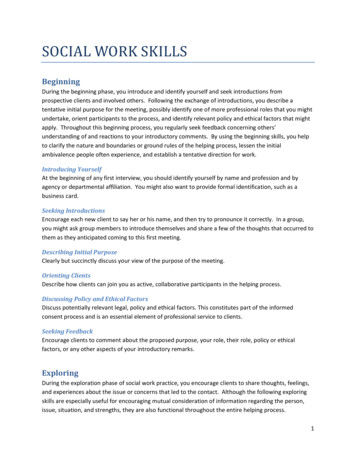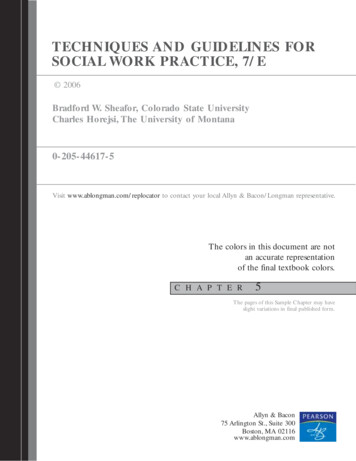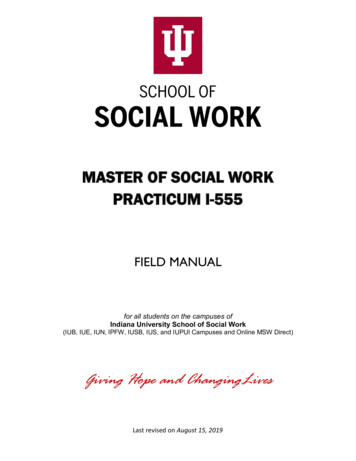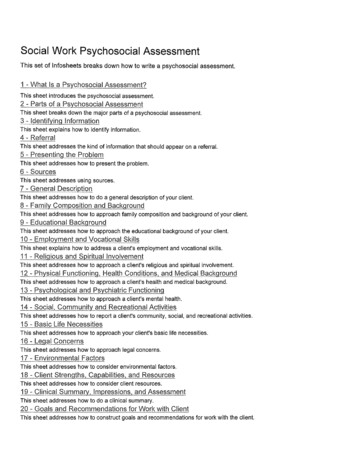
Transcription
Social Work PsychosocialAssessmentThis set of lnfosheetsbreaks down how to write a psychosocial assessment.1 - What Is a Psychosocial Assessment?This sheet introduces the psychosocial assessment.2 - Parts of a Psychosocial AssessmentThis sheet breaks down the major parts of a psychosocial assessment.3 - Identifying InformationThis sheet explains how to identify information.4 - ReferralThis sheet addresses the kind of information that should appear on a referral.5 - Presenting the ProblemThis sheet addresses how to present the problem.6 - SourcesThis sheet addresses using sources.7 - General DescriptionThis sheet addresses how to do a general description of your client.8 - Family Composition and BackgroundThis sheet addresses how to approach family composition and background of your client.9 - Educational BackgroundThis sheet addresses how to approach the educational background of your client.1O - Employment and Vocational SkillsThis sheet explains how to address a client's employment and vocational skills.11 - Religious and Spiritual InvolvementThis sheet addresses how to approach a client's religious and spiritual involvement.12 - Physical Functioning, Health Conditions, and Medical BackgroundThis sheet addresses how to approach a client's health and medical background.13 - Psychological and Psychiatric FunctioningThis sheet addresses how to approach a client's mental health.14 - Social, Community and Recreational ActivitiesThis sheet addresses how to report a client's community, social, and recreational activities.15 - Basic Life NecessitiesThis sheet addresses how to approach your client's basic life necessities.16 - Legal ConcernsThis sheet addresses how to approach legal concerns.17 - Environmental FactorsThis sheet addresses how to consider environmental factors.18 - Client Strengths, Capabilities, and ResourcesThis sheet addresses how to consider client resources.19 - Clinical Summary, Impressions, and AssessmentThis sheet addresses how to do a clinical summary.20 - Goals and Recommendations for Work with ClientThis sheet addresses how to construct goals and recommendations for work with the client.
21 - Why Clinical Documentation of Content MattersThis sheet explains why clinical documentation of content is important in the psychosocial assessment.22 - Objective Facts and Subjective ImpressionsThis sheet addresses how to distinguish between facts and impressions.23 - Difference between Facts and ImpressionsThis sheet continues to distinguish the difference between facts and impressions in writing the psychosocialassessment.24 - Tentative PhrasesThis sheet addresses tentative phrases.25 - Amount of Information to IncludeThis sheet addresses the amount of information appropriate to include in a psychosocial assessment.26 - Informational AccuracyThis sheet addresses the responsibility of verifying information on the psychosocial assessment.27 - Organization in Psychosocial AssessmentsThis sheet addresses how to organize a psychosocial assessment.
Writing a Psychosocial Assessment Infosheet #1What is a Psychosocial Assessment?As a social worker, one of the most important genres of writing you will use inorder to convey information about a particular client will be the psychosocialassessment. A psychosocial assessment is the social worker's summary as to theproblems to be solved. The social worker considers a variety of factors, which mayinclude the physical/psychiatric illness and its impact, results derived frompsychological tests, legal status, descriptions of the problem(s), existing assets andresources, the prognosis or prediction of outcome, and the plan designed to resolvethe problem(s).Your psychosocial assessment should: Communicate pertinent information about a client to colleagues for caseplanning and referral purposes. Establish in writing an account of "where the client is at" at a particularmoment in time during service provision; the psychosocial assessmentaccount offers baseline information about the client when he or she enters anagency for service. Offer the social worker an opportunity to reflect on, refine thinking, andraise questions about the client and his or her situation - to digestinformation about and impressions about the client through the process ofwriting about it.
Writing a Psychosocial Assessment Infosheet #2Parts of a Psychosocial AssessmentA psychosocial assessment is divided into three different sections, which containdifferent sub-headings: Basic Information1. Identifying Information2. Referral3. Presenting Problem4. Sources of Data5. General Description of Client Background and Current Functioning1. Family Composition and Background2. Educational Background3. Employment and Vocational Skills4. Religious/Spiritual Involvement5. Physical Functioning, Health Conditions, and Medical Background6. Psychological and Psychiatric Functioning and Background7. Social, Community, and Recreational Activities8. Basic Life Necessities9. Legal Concerns10.Other Environmental or Psychosocial Factors11.Client Strengths, Capacities, and Resources Impressions, Assessment, and Recommendations1. Clinical Summary, Impressions, and Assessment2. Goals and Recommendations for Work with ClientIn order to learn how to incorporate all of these different sections into yourfinished psychosocial assessment, please refer to the Infosheets for each particularsection.
Writing a Psychosocial Assessment Infosheet #3Identifying informationThe identifying information, which is included under the "basic information"section of your psychosocial assessment, should include the following:( Client nameGenderDate of birth and ageMarital statusRace, ethnicity, and nationality (if not born in the U.S.)LanguagespokenIncome (socioeconomic status)Neighborhood where client lives (general profile of community)Living arrangements (with whom does the client live?)Example:"Maria de los Angeles Arrieta, a 37-year-old single woman from Jalapa, Mexico,has been living in Jamaica, New York for the last ten years. She describes herselfas a "hard worker," and she describes how she has held the same position as aparalegal assistant for the last three years, after earning a promotion. Her income,depending on end-of-year bonuses, varies between 45,000 and 55,000 a year."
Writing a Psychosocial Assessment Infosheet #4What kind of information should be included in the referral section of thepsychosocial assessment?The referral, which is included under the "basic information" section of yourpsychosocial assessment, should include the following: Source (who referred the client to agency) Nature of request (what type of assistance is being sought?)Example:"Mr. Solomon first sought help after hearing about the agency's services from hissister-in-law. Even though Mr. Solomon cannot quite describe the source of hisproblems, he believes his ongoing sadness and depression are beginning to affecthis work, which worries him and has prompted several episodes of extreme anxiety.He believes a more serious, committed form of assistance is necessary in order toensure his success at work."
Writing a Psychosocial Assessment Infosheet #5Presenting the ProblemIn the "presenting the problem" section of your psychosocial assessment youshould: Describe the problem for which the client came (or was referred) for help.o Include client's definition of problem/need and expectations of service.o Include a brief history of the presenting problem: Length of duration of the problem Prior attempts to resolve the problem Previous involvement with social agencies for assistance withthe problemo If client is in crisis or considered "high risk" ( e.g., in danger: of beingabused, using violence against someone else, suicidal,decompensating, relapsing to drug use), describe and offer briefassessment of the riskExample:"Hal Solomon is a 32-year old entrepreneur whose presenting problem is a sense of unworthinessover earning more than a million dollars each years in the past 10 years of his work career. Hesays that the amount of money is considerably out of keeping with the degree of energy used,and that compared to people who "real work," it seems completely wrong for him to earn somuch money.Mr. Solomon came to the interview on time, wore dress slacks and a polo shirt, is deeply tanned,and says that he is 6' I'' and weighs 165 pounds. He runs 5 miles a day and works out at thegym at least an hour every day. He wore no rings or other jewelry, but he did have on a goldRolex watch. Initially, he moved around a great deal in his chair and his fingers continuallytapped on the arm of his chair. After 5 minutes, he slumped back in his chair, and, from time totime, wiped tears from his eyes as he discussed the impact his career has had on his formermarriage, family life, and on issues of intimacy. He comes to treatment for help in resolvingproblems of continued feelings of unworthiness, depression, and guilt that have lasted a durationof more than 2 years and which began with his divorce several years ago."From Glickr ""l,M.D. (2005) Improving the effectiveness of the helping professions:An evidence , Jsed approach to practice. Thousand Oaks, CA: Sage.
Writing a Psychosocial Assessment Infosheet #6How should you refer to your sources of data in your psychosocial assessment?In order to ensure accuracy in your psychosocial assessment, you should: Identify all the types of information used to write this assessment:o Interviewso Observationso Written materials (e.g., agency records)o Consultations with collateral contactso Records from this or referring agencyo Diagnostic test results (e.g., psychiatric, educational, psychological,vocational, medical) Describe client involvement in data collection processo Who was present during interview/s and observations?o How many times were interviews conducted, colleagues consulted, etc?o Over what period of time was the information gathered?Example:"Mr. Solomon came in for a series of weekly, one-hour long interviews, beginningat the end of September, and lasting until the second week of December. Duringthis time period, he was referred to a psychiatrist, who diagnosed him with chronicdepression in late October. As this was the first time Mr. Solomon had consultedwith a psychiatric expert, or with any kind of social work agency, this is the fullextent of diagnostic reports available."
Writing a Psychosocial Assessment Infosheet #8Family composition and backgroundThe family composition and background section should mention: Nuclear family members and significant relationships; list members, ages,marriage dates, deaths, divorces. Describe relationships-focus on maritaland parental strengths and difficulties, if relevant. Family of origin (family with whom one grew up); list members, ages,where they live, deaths, divorces. Describe all of these relationships. History of relevant substance abuse, legal problems, and/or psychiatricproblems among family members.Example:"Marie is the mother of two teenage children. Oliver, age 12, lives at home whileMichael, age 17, is currently in a boot camp in Mount Allen. She states she andOliver get along well and that he is doing well in school. She sees Michael everyother weekend and is hopeful that the boot camp experience will help him in thelong run."From Summers, Nancy. Fundamentals of Case Management, 2nd Edition,Thomson, Brooks/Cole, Belmon, Ca. 2006; p. 248.
Writing a Psychosocial Assessment Infosheet #9Educational backgroundThe educational background section should mention: School history and current status. This could include:o Highest level of education.o Degree/s earned.o Special school/educational talents, challenges, goals.Example:"Mr. Solomon became an entrepreneur in the computer field after his sophomoreyear at Standford University. he has not returned to finish his degree and says thathis lack of formal education makes him feel insecure about his intellectual abilities.however, he reads a great deal and has tried to make up for his lack of formaleducation by reading books recommended by people he respects."From Glicken, M.D. (2005) Improving the effectiveness of the helping professions:An evidence based approach to practice. Thousand Oaks, CA: Sage.
Writing a Psychosocial Assessment Infosheet #10What kind of information is included under the "employment and vocationalskills" section of your psychosocial assessment?The educational background section should mention: Occupation, work history, and current status (e.g., employed, unemployed,full-time, part-time). Special training/skills.Example:"Maria delos Angeles Arrieta has been working as a paralegal assistant inManhattan, New York for the last ten years. She completed her AA degreeeight years ago, and her workplace has offered several training seminars whichshe completed with enthusiasm, according to her description."
Writing a Psychosocial Assessment Infosheet #11Religious and spiritual involvementThe religious and spiritual involvement section should mention: Level of involvement with and support from religious community and/orspiritual practices and beliefs.Example:"Marie describes herself as a 'serious Catholic.' She attends Sunday mass everyweek, along with her two small children. She regularly attends other weekly,social gatherings organized by her church."
Writing a Psychosocial Assessment Infosheet #12Physical functioning, health conditions, and medical backgroundThe physical functioning, health conditions and medical background sectionshould mention: Physical development, general health, disabilities, and current functioning. History of disease, accidents, genetic predispositions, and prescriptionmedication.Example:"Simon Kowalsky is in general good health, although he complains sometimesabout headaches and general tiredness. He has consulted with his generalphysician in regards to this condition, who seems to believe it is stress related. Heis currently managing this condition through non-prescription medication, such asaspirin. His family, in particular on his father's side, has a history of heart disease,which contributes to Mr. Kowalsky's uneasiness concerning his stress levels."
Writing a Psychosocial Assessment Infosheet #13What kind of information is included under the "psychological andpsychiatric functioning and background" section of your psychosocialassessment?The psychological and psychiatric functioning and background section shouldmention: History of mental health/psychiatric problems, prescription medication,addictions (e.g., alcohol and other drug use). History of physical, mental, and/ or sexual abuse or neglect.Example:"[Mr. Solomon] reports . depression or anxiety in his life, which occurred aboutthe time he decided to marry. He believes the cause of his depression was theconflict with his parents over the marriage. He says that he is healthy, although hesometimes feels easily fatigued . He was on a tranquilizer several y ears agobecause of anxiety and depression during the divorce but cannot remember thename of the medication. He says that it made him sleepy and that he discontinuedits use because it interfered with his work."From Glicken, M.D. (2005) Improving the effectiveness of the helping professions:An evidence based approach to practice. Thousand Oaks, CA: Sage.
Writing a Psychosocial Assessment Infosheet #14Social, community, and recreational activitiesThe social, community, and recreational activities section should mention: Social functioning, (are there any significant :friendships, interpersonalrelationships, support network?) Use of community organizations or resources (e.g., as client, member,volunteer)? Hobbies/leisure involvement.Example:"Bill states that he has a number of friends and sings in his church choir. Lastsummer he joined a local baseball team and intends to this summer as well. Helikes sports and goes to games with friends."From Summers, Nancy. Fundamentals of Case Management, 2nd Edition,Thomson, Brooks/Cole, Belman, Ca. 2006; p. 248.
Writing a Psychosocial Assessment Infosheet #15What kind of information is included under the "basic life necessities" sectionof your psychosocial assessment?The basic life necessities section should mention: How is client functioning with respect to basic life necessities-food, housing,employment? What entitlements does the client receive? What assistance does clientrequire?Example:"Mr. Solomon has held his current job for over 5 years, and he describes hisincome as 'more than enough.' He describes a feeling of accomplishmentregarding the ownership of his own apartment."
Writing a Psychosocial Assessment Infosheet #16What kind of information is included under the "legal concerns" section ofyour psychosocial assessment?The legal concerns section should include: Immigrant status, housing, marital issues, domestic violence,parole/probation, DWI's?Example:"During the first few meetings, Ms. Arrieta described her worries regarding anex-boyfriend who she described as "abusive." During her three-monthrelationship with this man, Ms. Arri.eta had been concerned with his temper, andhis verbal, violent threats. After ending the relationship, she had received a fewphone calls from him, and at the beginning of our sessions, she had consideredcalling the police. After a few sessions, however, she had decided againstcalling the police, as she heard from a friend that her ex-boyfriend had movedout of the state."
Writing a Psychosocial Assessment Infosheet #17What kind of information is included under the "other environmental orpsychosocial factors" section of your psychosocial assessment?The other environmental or psychosocial factors section should include: Military service, sexuality issues, etc.Example:"During several of our interviews, Mr. Olvera commented on the military servicehe completed in his home country, Mexico, as a source of great concern; it wasduring this service that he first began to struggle with his sexuality, feeling that hispeers in the volunteer army would shun him or "reject him" if they knew he wasgay. Even though he never actually revealed his sexuality to any of his friends inhis home country, the anxiety provoked by these experiences still "follows" him,as he himself reported during several of our sessions."
Writing a Psychosocial Assessment Infosheet #18What kind of information is included under the "client strengths, capacities,and resources" section of your psychosocial assessment?The client strengths, capacities, and resources section should address: How does the client cope? What are his/her strengths and problem-solvingcapacities? What are his/her limitations to deal with the current problem/s?Example:"While [Mr. Solomon] complains of depression and fatigue, he continues to dowell in his work, exercises daily, and has widely invested his large income for thefuture. He is an avid reader and has tried to use available literature to understandand resolve many of his problems, sometimes effectively."From Glicken, M.D. (2005) Improving the effectiveness of the helping professions:An evidence based approach to practice. Thousand Oaks, CA: Sage.
Writing a Psychosocial Assessment Infosheet #19Clinical summary, impressions, and assessmentThe clinical summary, impressions, and assessment section should: First give a brief, 3-5 sentence summary of what you have already written:o Identify the primary problem, need, or concern the client is dealingwith and contributing factors.a Also, describe the sense of urgency the client has with the problem/s.aIdentify secondary problems, needs, or concerns if these are raised. Summarize how the client appeared during the interview/s.aGive an overview of client's mood, signs of anxiety or depression,problems with memory, speech, sense of reality, judgment, attitudetoward their situation/difficulty.aIndicate how the client related to you. Your impressions giveimportant clues to w
As a social worker, one of the most important genres of writing you will use in order to convey information about a particular client will be the psychosocial assessment. A psychosocial assessment is the social worker's summary as to the problems
